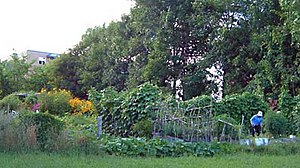This article's lead section may be too short to adequately summarize the key points. (November 2016) |

A community garden is a piece of land gardened or cultivated by a group of people individually or collectively. Normally in community gardens, the land is divided into individual plots. Each individual gardener is responsible for their own plot and the yielding or the production of which belongs to the individual.[1] In collective gardens the piece of land is not divided. A group of people cultivate it together and the harvest belongs to all participants. Around the world, community gardens exist in various forms, it can be located in the proximity of neighborhoods or on balconies and rooftops. Its size can vary greatly from one to another.
Community gardens have experienced three waves of major development in North America. The earliest wave of community gardens development coincided with the Industrial Revolution and rapid urbanization process in Europe and North America; they were then called 'Jardin d'ouvrier' (or workers' garden). The second wave of community garden development happened during the WWI and WWII; they were part of "Liberty Gardens" and "Victory Gardens" respectively. The most recent wave of community garden development happened in the 1970s during the OPEC crisis, results of grassroots movement in quest for available land to combat against food insecurity.[2]
More recently, community gardens have seen a global resurgence. This may be related to several issues faced by the global population in the 21st century, such as ecological crisis, climate change and the new sanitary crisis.[clarification needed][3] Community gardens contribute to the urban agriculture movement and the requests from citizens for more community gardens has been surging in recent years.
- ^ "What is a community garden?". American Community Garden Association. Archived from the original on 2007-12-04.
- ^ Vikram, Bhatt (2016). "Cultivating Montreal: A Brief History of Citizens and Institutions Integrating Urban Agriculture in the City". UAR2 Urban Agriculture & Regional Food Systems. 1 (1): 1–12. doi:10.2134/urbanag2015.01.1511. S2CID 56294530.
- ^ Lovell, Rebecca; Husk, Kerryn; Bethel, Alison; Garside, Ruth (2014-10-07). "What are the health and well-being impacts of community gardening for adults and children: a mixed method systematic review protocol". Environmental Evidence. 3 (1): 20. Bibcode:2014EnvEv...3...20L. doi:10.1186/2047-2382-3-20. hdl:10871/19910. ISSN 2047-2382. S2CID 3884117.